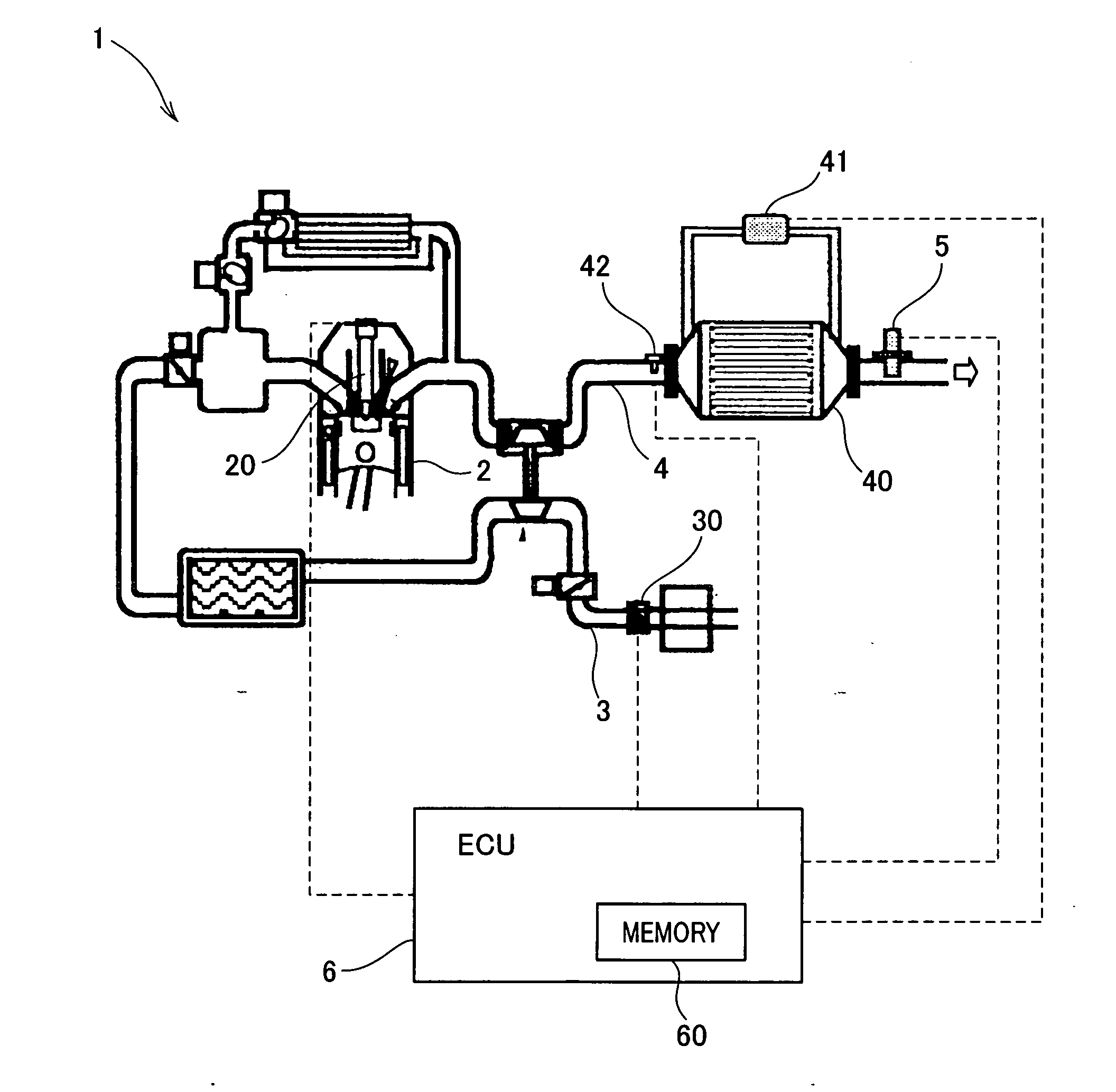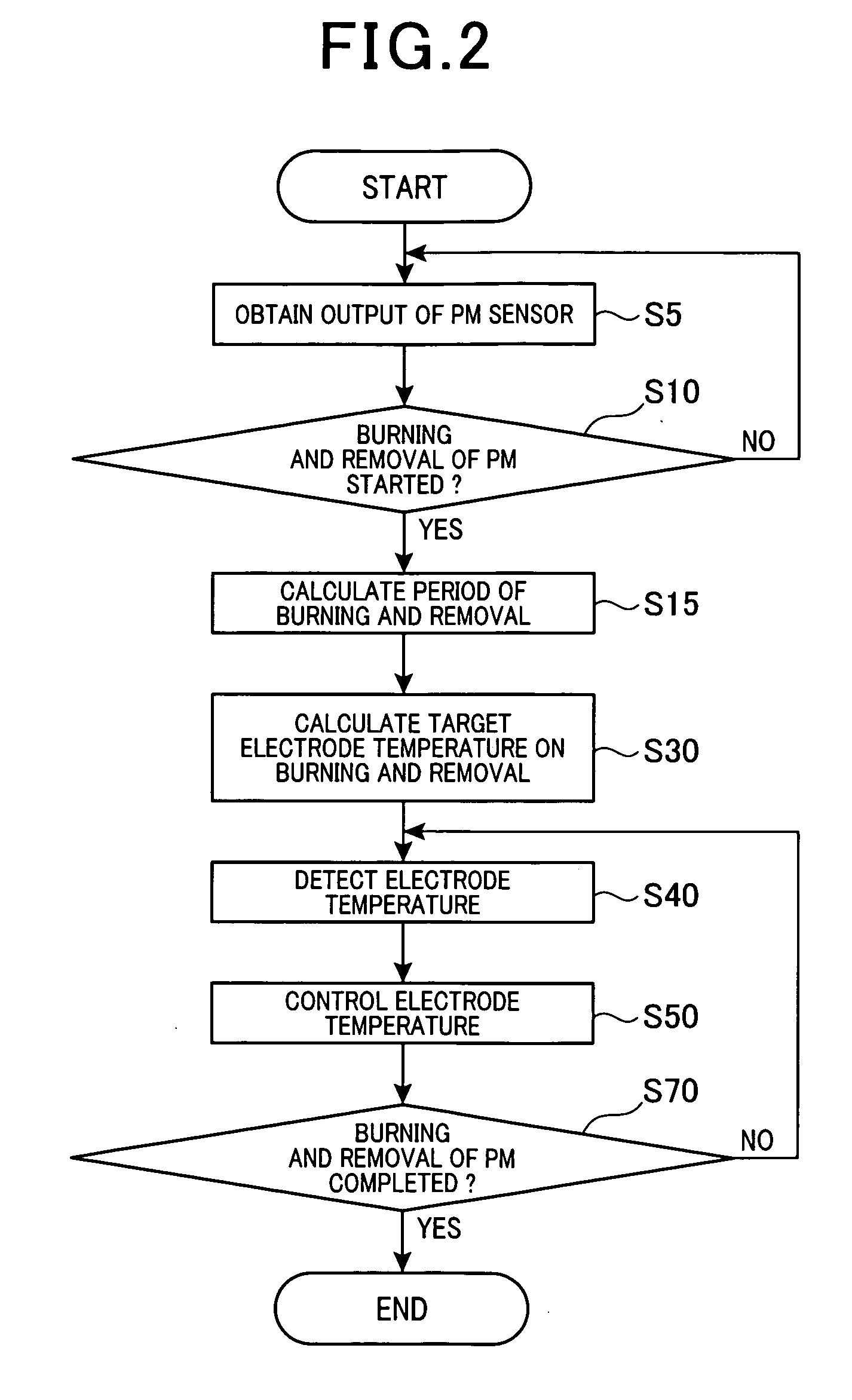Detection apparatus
a technology of detection apparatus and detection device, which is applied in the direction of engine controllers, machines/engines, electric control, etc., can solve the problem of prolonging the regeneration process and achieve the effect of high accuracy
- Summary
- Abstract
- Description
- Claims
- Application Information
AI Technical Summary
Benefits of technology
Problems solved by technology
Method used
Image
Examples
first embodiment
[0054]FIG. 1 is a schematic diagram illustrating a detection system (detection apparatus) 1 according to a first embodiment of the present invention. The detection system 1 may be applied to e.g., an automotive vehicle.
[0055]The detection system 1 is a system that detects an amount of PM flowing through an exhaust pipe (exhaust path) 4 of a diesel engine 2 (engine) that is an internal combustion engine. The detection system 1 includes an intake pipe 3, the exhaust pipe 4, a PM sensor 5, and an electronic control unit 6. Through the intake pipe 3, intake gas (air) is supplied to the engine 2. The intake pipe 3 is provided with an air flow meter 30 that detects an intake volume (e.g., a mass flow rate per unit time). In a cylinder of the engine 2, fuel is injected by an injector 20.
[0056]The exhaust pipe 4 is provided with a DPF 40, a differential-pressure meter 41, and an exhaust gas temperature sensor 40. The DPF 40 collects PM emitted by the engine 2. The differential-pressure mete...
second embodiment
[0071]Next, a second embodiment of the present invention is described. In the second embodiment, while the regeneration process is performed, the attached amount of the remaining PM in the PM sensor is calculated, the target electrode temperature is adjusted based on the attached amount of the remaining PM during the regeneration, and the regeneration period is also adjusted based on the electrode temperature during the regeneration.
[0072]The configuration of FIG. 1 is also used in the second embodiment. Hereinafter, a part of the second embodiment different from the first embodiment is described. In the second embodiment, processes in steps of a flowchart shown in FIG. 5, not FIG. 2, are executed. In the flowchart of FIG. 5, steps S5, S10, S30, S40, S50, and S70 (the same references as FIG. 2) are the same as that of FIG. 2. Step S15 of FIG. 2 is omitted from the flowchart of FIG. 5. In FIG. 2, steps S20, S60 and S65 are newly added and executed. At step S70, if the ECU 6 judges NO...
third embodiment
[0085]Next, a third embodiment of the present invention is described. In the third embodiment, the regeneration period is not calculated as the first and second embodiments, but the attached amount of the remaining PM in the PM sensor 5 during the regeneration process of the PM sensor 5 is calculated, and, if the attached amount of the remaining PM becomes sufficiently small, the regeneration process is completed. The configuration of FIG. 1 is also used in the third embodiment. Hereinafter, a part of the third embodiment different from the second embodiment is described.
[0086]In the third embodiment, processes in steps of a flowchart shown in FIG. 11, not FIG. 5, are executed. In the flowchart of FIG. 11, each steps S5, S10, S20, S30, S40, S50, and S65 (the same references as FIG. 2) is the same process as those of FIG. 5. Step S60 of FIG. 5 is omitted from the flowchart of FIG. 11, because the calculation of the regeneration period is unnecessary. The process in step S70 of FIG. 5...
PUM
 Login to View More
Login to View More Abstract
Description
Claims
Application Information
 Login to View More
Login to View More - R&D
- Intellectual Property
- Life Sciences
- Materials
- Tech Scout
- Unparalleled Data Quality
- Higher Quality Content
- 60% Fewer Hallucinations
Browse by: Latest US Patents, China's latest patents, Technical Efficacy Thesaurus, Application Domain, Technology Topic, Popular Technical Reports.
© 2025 PatSnap. All rights reserved.Legal|Privacy policy|Modern Slavery Act Transparency Statement|Sitemap|About US| Contact US: help@patsnap.com



